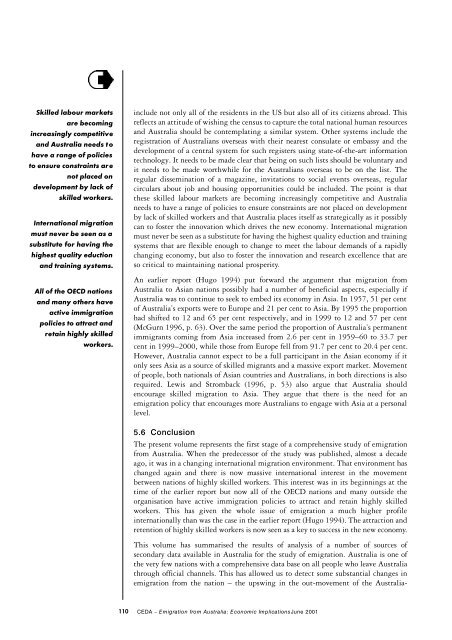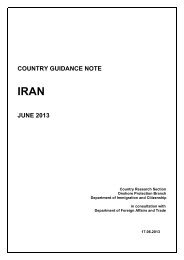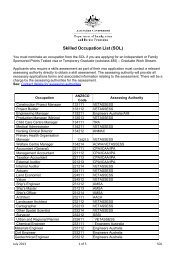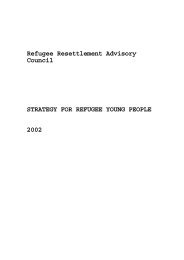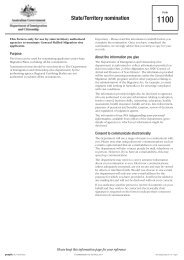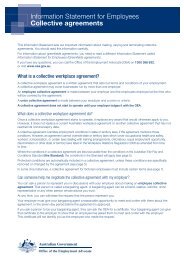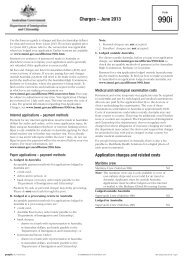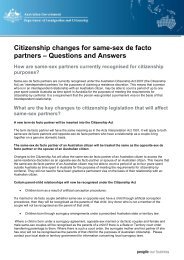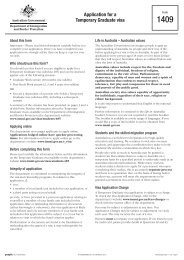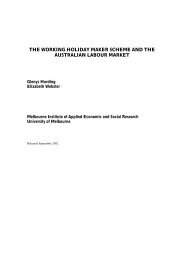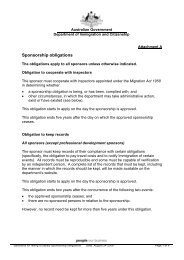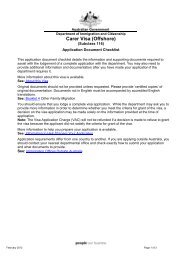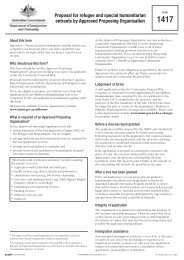part three - Department of Immigration & Citizenship
part three - Department of Immigration & Citizenship
part three - Department of Immigration & Citizenship
Create successful ePaper yourself
Turn your PDF publications into a flip-book with our unique Google optimized e-Paper software.
Skilled labour markets<br />
are becoming<br />
increasingly competitive<br />
and Australia needs to<br />
have a range <strong>of</strong> policies<br />
to ensure constraints are<br />
not placed on<br />
development by lack <strong>of</strong><br />
skilled workers.<br />
International migration<br />
must never be seen as a<br />
substitute for having the<br />
highest quality eduction<br />
and training systems.<br />
All <strong>of</strong> the OECD nations<br />
and many others have<br />
active immigration<br />
policies to attract and<br />
retain highly skilled<br />
workers.<br />
include not only all <strong>of</strong> the residents in the US but also all <strong>of</strong> its citizens abroad. This<br />
reflects an attitude <strong>of</strong> wishing the census to capture the total national human resources<br />
and Australia should be contemplating a similar system. Other systems include the<br />
registration <strong>of</strong> Australians overseas with their nearest consulate or embassy and the<br />
development <strong>of</strong> a central system for such registers using state-<strong>of</strong>-the-art information<br />
technology. It needs to be made clear that being on such lists should be voluntary and<br />
it needs to be made worthwhile for the Australians overseas to be on the list. The<br />
regular dissemination <strong>of</strong> a magazine, invitations to social events overseas, regular<br />
circulars about job and housing opportunities could be included. The point is that<br />
these skilled labour markets are becoming increasingly competitive and Australia<br />
needs to have a range <strong>of</strong> policies to ensure constraints are not placed on development<br />
by lack <strong>of</strong> skilled workers and that Australia places itself as strategically as it possibly<br />
can to foster the innovation which drives the new economy. International migration<br />
must never be seen as a substitute for having the highest quality eduction and training<br />
systems that are flexible enough to change to meet the labour demands <strong>of</strong> a rapidly<br />
changing economy, but also to foster the innovation and research excellence that are<br />
so critical to maintaining national prosperity.<br />
An earlier report (Hugo 1994) put forward the argument that migration from<br />
Australia to Asian nations possibly had a number <strong>of</strong> beneficial aspects, especially if<br />
Australia was to continue to seek to embed its economy in Asia. In 1957, 51 per cent<br />
<strong>of</strong> Australia’s exports were to Europe and 21 per cent to Asia. By 1995 the proportion<br />
had shifted to 12 and 65 per cent respectively, and in 1999 to 12 and 57 per cent<br />
(McGurn 1996, p. 63). Over the same period the proportion <strong>of</strong> Australia’s permanent<br />
immigrants coming from Asia increased from 2.6 per cent in 1959–60 to 33.7 per<br />
cent in 1999–2000, while those from Europe fell from 91.7 per cent to 20.4 per cent.<br />
However, Australia cannot expect to be a full <strong>part</strong>icipant in the Asian economy if it<br />
only sees Asia as a source <strong>of</strong> skilled migrants and a massive export market. Movement<br />
<strong>of</strong> people, both nationals <strong>of</strong> Asian countries and Australians, in both directions is also<br />
required. Lewis and Stromback (1996, p. 53) also argue that Australia should<br />
encourage skilled migration to Asia. They argue that there is the need for an<br />
emigration policy that encourages more Australians to engage with Asia at a personal<br />
level.<br />
5 . 6 C o n c l u s i o n<br />
The present volume represents the first stage <strong>of</strong> a comprehensive study <strong>of</strong> emigration<br />
from Australia. When the predecessor <strong>of</strong> the study was published, almost a decade<br />
ago, it was in a changing international migration environment. That environment has<br />
changed again and there is now massive international interest in the movement<br />
between nations <strong>of</strong> highly skilled workers. This interest was in its beginnings at the<br />
time <strong>of</strong> the earlier report but now all <strong>of</strong> the OECD nations and many outside the<br />
organisation have active immigration policies to attract and retain highly skilled<br />
workers. This has given the whole issue <strong>of</strong> emigration a much higher pr<strong>of</strong>ile<br />
internationally than was the case in the earlier report (Hugo 1994). The attraction and<br />
retention <strong>of</strong> highly skilled workers is now seen as a key to success in the new economy.<br />
This volume has summarised the results <strong>of</strong> analysis <strong>of</strong> a number <strong>of</strong> sources <strong>of</strong><br />
secondary data available in Australia for the study <strong>of</strong> emigration. Australia is one <strong>of</strong><br />
the very few nations with a comprehensive data base on all people who leave Australia<br />
through <strong>of</strong>ficial channels. This has allowed us to detect some substantial changes in<br />
emigration from the nation – the upswing in the out-movement <strong>of</strong> the Australia-<br />
110 C E DA – Emigration from Australia: Economic ImplicationsJune 2001


